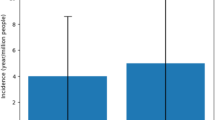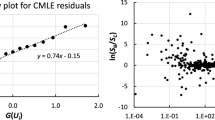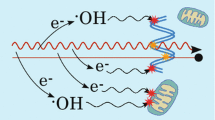Abstract
Radiological properties of gel dosimeters and phantom materials are often compared against each other and against water or tissue by consideration parameters including their effective atomic number, Zeff. Effective atomic numbers have been calculated for a range of ferrous-sulphate and polymeric gel dosimeters using mass attenuation coefficient data over the energy range 10 keV to 10 MeV. Data is presented relative to water to allow direct comparison over a range of energies. These data provide energy specific values of Zeff which improves on the practice of applying a power-law based formula to estimate an energy independent value. For applications that require a single value of Zeff, the data presented here allows the choice of a value appropriate to the energy of the photon source or a spectrum-weighted average. Studying the variation of Zeff, which is equivalent to taking into account the variation of mass attenuation coefficients with photon energy, it is found that gels typically match water better than water matches human tissues. As such, the subtle differences in effective atomic number between water and gels are small and may be considered negligible. Consideration of the mean disparity over a large energy range shows, broadly, BANG-1 to be the most water equivalent gel.
Similar content being viewed by others
References
Moseley, H.The high frequency spectra of the elements, Phil. Mag. 26 1024–1034, 1913.
Bragg, W. and Peirce, S.The absorption coefficients of x-rays, Phil. Mag. 28 626–630, 1914.
Owen, E.The absorption of x-rays, Proc. Roy. Soc. 94 510–524, 1919.
Richtmyer, F. Z. and Warburton, F.The absorption of x-rays by iron, cobalt, nickel and copper, Phys. Rev. 22 539–545, 1923.
DeDeene, Y., Vergote, K., Claeys, C. and DeWagter, C.The fundamental radiation properties of normoxic polymer gel dosimeters: a comparison between a methacrylic acid based gel and acrylamide based gels, Physics in Medicine and Biology 51 653–673, 2006.
Farajollaha, A., Bonnet, D., Ratcliffe, A., Aukett, R. and Mills, J.An investigation into the use of polymer gel dosimeters in low dose rate brachytherapy, Br J Radiol 72 1085–1092, 1999.
Jirasek, A., Hilts, M., Shaw, C. and Baxter, P.Investigation of tetrakis hydroxymethl phosphonium chloride as an antioxidant for use in x-ray computed tomography polyacrylamide gel dosimetry, Physics in Medicine and Biology 51 1891–1906, 2006.
Luci, J., Whitney, H. and Gore, J.Optimization of MAGIC gel formulation for three-dimensional radiation therapy dosimetry, Physics in Medicine and Biology 52 N241-N248, 2007.
Pantelis, E., Karlis, A., Kozicki, M., Papagiannis, P., Sakelliou, L. and Rosiak, J.Polymer gel water equivalence and relative energy response with emphasis on low photon energy dosimetry in brachytherapy, Physics in Medicine and Biology 49 3495–3514, 2004.
Venning, A., Hill, B., Brindha, S., Healy, B. and Baldock, C.Investigation of the PAGAT polymer gel dosimeter using magnetic resonance imaging, Physics in Medicine and Biology 50 3875–3888, 2005.
Mayneord, W.The significance of the Röntgen, Acta — Unio Internationalis Contra Cancrum 2 271–282, 1937
Kumar, T. and Reddy, K.Effective atomic numbers for materials of dosimetric interest, Radiat Phys Chem 50 545–553, 1997.
Prasad, S., Parthasaradhi, K. and Bloomer, W.Effective atomic numbers of composite materials for total and partial interaction processes for photons, electrons and protons, Med Phys 24 883–885, 1997.
Jayachandran, C.Calculated effective atomic number and kerma values for tissue-equivalent and dosimetry materials, Physics in Medicine and Biology 16 617–623, 1971
Parthasaradhi, K., Rao, B. and Prasad, S.Effective atomic numbers of biological materials in the energy region 1 to 50 MeV for photons, electrons and He ions, Med Phys 16 653–654, 1989.
Rao, B., Raju, M., Narasimham, K., Parthasaradhi, K. and Rao, B.Interaction of low-energy photons with biological materials and the effective atomic number, Med Phys 12 745–748, 1985.
Kron, T., Metcalfe, P. and Pope, J.Investigation of the tissue equivalence of gels used for NMR dosimetry, Physics in Medicine and Biology 38 139–150, 1993.
Kahn, F.The physics of radiation therapy (3rd Ed.), (Lippincott Williams & Wilkins, Philadelphia USA) Page 82, 2003.
Spiers, W.Effective atomic number and energy absorption in Tissues, Br J Radiol 19 52–63, 1946.
Walter, B.Uber die besten Formeln zur Berechnung der Absorption der Rontgenstrahlen in einem beliebigen Stoff Fortschr. a.d. Geb. der Roentg. 35 929, 1929.
Murty, R.Effective atomic numbers of heterogeneous Materials Nature 207 398–399, 1965.
Hine, G.Secondary electron emission and effective atomic Numbers Nucleonics 10 9–15, 1952.
Weber, J. and van den Berge, D.The effective atomic number and the calculation of the composition of phantom materials, Br J Radiol 42 378–383, 1969.
White, D.An analysis of the Z-dependence of photon and electron interactions, Physics in Medicine and Biology 22 219–228, 1977.
McCullough, E.Photon attenuation in computed tomography Med Phys 2 307–320, 1975.
Henrikson, T. and Baarli, J.The effective atomic number Radiat. Res. 6 415–423, 1957.
White, D.Effective atomic numbers in the formulation of tissue substitute materials for photons, Radiat. Res. 76 23–31, 1978.
Jackson, D. and Hawkes, D.X-ray attenuation coefficients of elements and mixtures, Phys. Rep. 70 169–233, 1981.
ICRUReport No 44: Tissue substitutes in radiation dosimetry and measurement, (International Commission of Radiation Units and Measurements, Bethesda, MD) Pages, 1989.
NIST(accessed May) http://physics.nist.gov/cgi-bin/ Star/ compos.pl, 2006.
Keall, P. and Baldock, C.A theoretical study of the radiological properties and water equivalence of Fricke and polymer gels used for radiation dosimetry, Australas. Phys. Eng. Sci. Med. 22 85–91, 1999.
Maryanski, M., Gore, J., Kennan, R. and Schulz, R.NMR relaxation enhancement in gels polymerized and cross-linked by ionizing radiations: a new approach to 3-D dosimetry by, MRI Magn. Reson. Imag. 11 253–258, 1993.
Maryanski, M., Schulz, R., Ibbott, G., Gatenby, J., Xie, J., Horton, D. and Gore, J.Magnetic resonance imaging of radiation dose distributions using a polymer-gel dosimeter, Physics in Medicine and Biology 39 1437–1455, 1994.
Baldock, C., Burford, R., Billingham, N., Wagner, G., Patval, S., Badawi, R. and Keevil, S.Experimental procedure for the manufacture and calibration of polyacrylamide gel (PAG) for magnetic resonance imaging (MRI) radiation dosimetry, Physics in Medicine and Biology 43 695–702, 1998.
Trapp, J., Michael, G., DeDeene, Y. and Baldock, C.Attenuation of diagnostic energy photons by polymer gel Dosimeters, Physics in Medicine and Biology 47 4247–4258, 2002.
Maryanski, M., Ibbott, G., Schulz, R. and Gore, J.Radiation therapy dosimetry using magnetic resonance imaging of polymer gels, Med Phys 23 699–705, 1996.
Sandilos, P., Angelopoulos, A., Baras, P., Dardoufas, K., Karaiskos, P., Kipouros, P., Kozicki, M., Rosiak, J., Sakelliou, L., Seimenis, I. and Vlahos, L.Dose verification in clinical IMRT prostate incidents, Int. J. Radiat. Oncol. Biol. Phys. 59 1540–1547, 2004.
Kipouros, P., Pappas, E., Baras, P., Hatzipanayoti, D., Karaiskos, P., Sakelliou, L., Sandilos, P. and Seimenis, I.Wide dynamic dose range of VIPAR polymer gel dosimetry, Physics in Medicine and Biology 46 2143–2159, 2001.
Pappas, E., Angelopoulos, A., Kipouros, P., Vlachos, L., Xenofos, S. and Semenis, I.Evaluation of the performance of VIPAR polymer gels using a variety of x-ray and electron Beams, Physics in Medicine and Biology 48 N65-N73, 2003.
Pappas, E., Maris, T., Angelopoulos, A., Paparigopoulou, M., Sakelliou, L., Sandiolos, P., Voyiatzi, S. and Vlachos, L.A new polymer gel for magnetic resonance imaging (MRI) radiation dosimetry, Physics in Medicine and Biology 44 2677–2684, 1999.
Fong, P., Keil, D., Does, M. and Gore, J.Polymer gels for magnetic resonance imaging of radiation dose distributions at normal room atmosphere, Physics in Medicine and Biology 51 3105–3113, 2001.
Gustavsson, H., Back, S., Lepage, M., Rintoul, L. and Baldock, C.Development and optimization of 2-hydroxyethylacrylate MRI polymer gel dosimeter, Physics in Medicine and Biology 49 227–241, 2004.
DeDeene, Y., Hurley, C., Venning, A., Vergote, K., Mather, M., Healy, B. and Baldock, C.A basic study of some normoxic polymer gel dosimeters, Physics in Medicine and Biology 47 3441–3463, 2002.
Hurley, C., Venning, A. and Baldock, C.A study of a normoxic gel dosimeter comprising methacrylic acid, gelatine and tetrakis (hydroxymethyl) phosphonium chloride (MAGAT), Appl. Radiat. Isot. 63 443–456, 2005.
Venning, A., Nitschke, K., Keall, P. and Baldock, C.Radiological properties of normoxic polymer gel dosimeters, Med Phys 32 1047–1053, 2005.
DeDeene, Y., Venning, A., Hurley, C., Healy, B. and Baldock, C.Dose-response stability and integrity of the dose distribution of various polymer gel dosimeters, Physics in Medicine and Biology 47 2459–2470, 2002.
Senden, R., DeJean, P., McAuley, K. and Schreiner, L.Polymer gel dosimetry with reduced toxicity: a preliminary investigation of the NMR and optical dose-response using different monomers, Physics in Medicine and Biology 51 3301–3314, 2006.
Barkla, C. and Sadler, C.Secondary x-rays and the atomic weight of nickel Phil. Mag. 14 408–422, 1907.
Barkla, C. and Sadler, C.The absorption of Röntgen rays Phil. Mag. 17 739–760, 1909.
Hubbell, F. and Seltzer, S.Tables of x-ray mass attenuation coefficients and mass energy-absorption coefficients from 1 keV to 20 MeV for elements Z=1 to 92 and 48 substances of dosimetric interest, NIST-5632, 1995.
Hubbell, J.Compilation of photon cross-sections: some historical remarks and current status X-Ray Spectrom 28 215–223, 1999.
Hubbell, J.Photon mass attenuation and energy-absorption coefficients from 1 keV to 20 MeV, Int. J. Appl. Radiat. Isot. 33 1269–1290, 1982.
Scofield, J.Theoretical photoionization cross sections from 1 to 1500 keV, Lawrence Livermore Laboratory Report UCRL-51326, 1973.
Saloman, E., Hubbell, J. and Scofield, J.X-ray attenuation cross sections for energies 100 eV to 100 keV and elements Z=1 to 92 At. Data Nucl. Data Tables 38 1–197, 1988.
Parthasaradhi, K.Effective atomic numbers in compounds Indian J. Pure & App. Phys. 6 574–575, 1968.
Mohan, R., Chui, C. and Lidofsky, L.Energy and angular distributions of photons from medical linear accelerators Med Phys 12 592–597, 1985.
Sellakumar, P., Samuel, E. and Supe, S.Water equivalence of polymer gel dosimeters Radiat Phys Chem 76 1108–1115, 2007.
Author information
Authors and Affiliations
Corresponding author
Rights and permissions
About this article
Cite this article
Taylor, M.L., Franich, R.D., Trapp, J.V. et al. The effective atomic number of dosimetric gels. Australas. Phys. Eng. Sci. Med. 31, 131–138 (2008). https://doi.org/10.1007/BF03178587
Received:
Accepted:
Issue Date:
DOI: https://doi.org/10.1007/BF03178587




